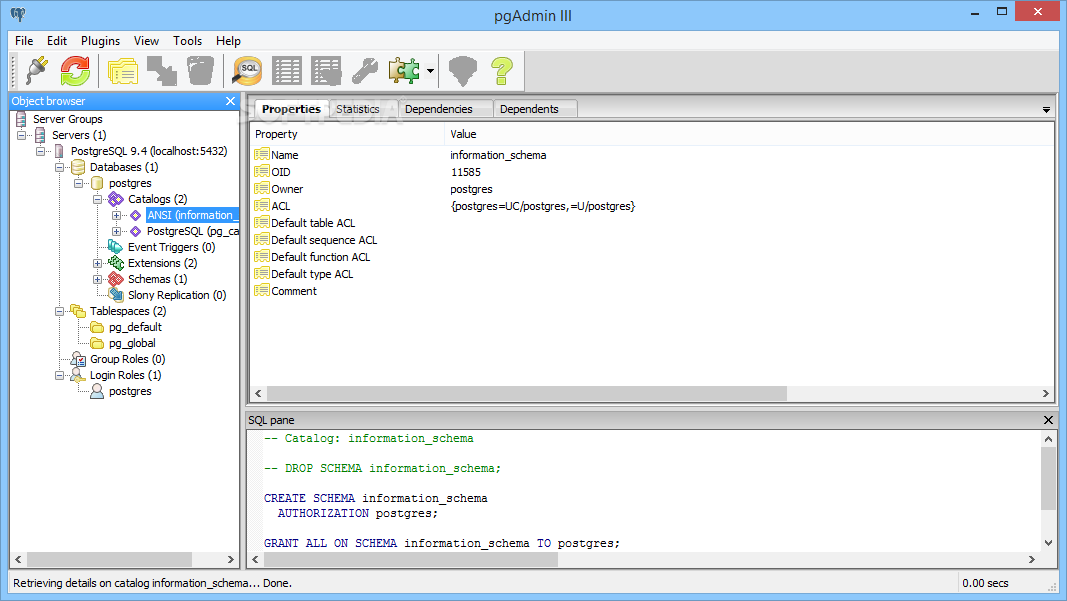

- #Postgresql tutorial data file how to
- #Postgresql tutorial data file pdf
- #Postgresql tutorial data file .exe
- #Postgresql tutorial data file install
- #Postgresql tutorial data file driver
Finally, append a forward slash and the name of your data base instance to the end of the URL. Enter or paste the endpoint (including port) of the DB Instance after "jdbc:postgresql://". URL: You can find your JDBC URL on the Amazon RDS console as shown in the screenshot to the right.
#Postgresql tutorial data file driver
In the next dialog box, click the folder icon and select the driver you downloaded in the previous step. Note: When you select a driver from the drop-down menu you will be prompted to edit the driver definition.
#Postgresql tutorial data file pdf
See the PDF file included in the download for details.ī.
#Postgresql tutorial data file .exe
exe file (Windows) or the shell script (macOS, Linux) included in the download folder. Note: You can launch the application using the.
#Postgresql tutorial data file install
After you have completed your download, install SQL Workbench. In this step, we will connect to the database you created using SQL Workbench.Ī. For more information, see Viewing DB Instance Metrics. Enabling enhanced monitoring will give you metrics in real time for the operating system (OS) that your DB instance runs on.

For more information about Performance Insights, a database performance and monitoring feature, see the Performance Insights web page.Įnhanced monitoring: Select Enable enhanced monitoring. Select Disable Performance Insights for this tutorial. Backup window: Use the default of No preference.For this tutorial, set this value to 1 day. Backup retention period: You can choose the number of days to retain the backup you take.For more information, see Encrypting Amazon RDS Resources. This option is not available in the Free Tier. For more information, see Working with Option Groups. Amazon RDS uses option groups to enable and configure additional features. Option group: This option is not available in the Free Tier.For more information, see Working with DB Parameter Groups. DB parameter group : Leave the default value.If you do not provide a name, Amazon RDS will not automatically create a database on the DB instance you are creating. Database name: Type a database name that is 1 to 64 alphanumeric characters.
#Postgresql tutorial data file how to
In this tutorial, you have learned how to load the dvdrental sample database into the PostgreSQL database server for practicing PostgreSQL.In the Additional Configurations section: Sixth, the restoration process will complete in few seconds and shows the following dialog once it completes:įinally, open the dvdrental database from object browser panel, you will find tables in the public schema and other database objects as shown in the following picture: You’ll see the new empty database created under the Databases node:įourth, right-click on the dvdrental database and choose Restore… menu item to restore the database from the downloaded database file:įifth, enter the path to the sample database file e.g., c:\sampledb\dvdrental.tar and click the Restore button: Third, enter the database name dvdrental and click the Save button: Second, right click the Databases and select the Create > Database… menu option: The following shows you step by step on how to use the pgAdmin tool to restore the sample database from the database file:įirst, launch the pgAdmin tool and connect to the PostgreSQL server. Load the DVD Rental database using the pgAdmin It takes about seconds to load data stored in the dvdrental.tar file into the dvdrentaldatabase.


 0 kommentar(er)
0 kommentar(er)
